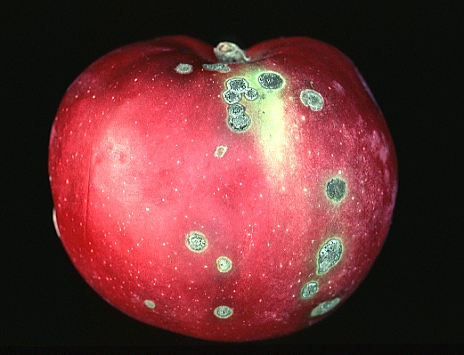| Admissions | Accreditation | Booksellers | Catalog | Colleges | Contact Us | Continents/States/Districts | Contracts | Examinations | Forms | Grants | Hostels | Honorary Doctorate degree | Instructors | Lecture | Librarians | Membership | Professional Examinations | Programs | Recommendations | Research Grants | Researchers | Students login | Schools | Search | Seminar | Study Center/Centre | Thesis | Universities | Work counseling |
|
What plant diseases can an apple tree get? Apple Scab Cedar Apple Rust Description  The fungus that causes apple scab on apples and crabapples is Venturia inaequalis. There are related fungi that cause scab on other plants in the rose family. Symptoms Symptoms usually start on the undersides of leaves. Spots, at first, are small, irregular lesions that are light brown to olive green in color. As infection continues, lesions become more circular and velvety olive green in color. Spots eventually turn dark brown to black. Infected tissue thickens, causing the upper surface to bulge upwards and the lower surface to depress. Leaves may curl and scorch at the margins. If the leaf petioles become infected, the leaves drop early. If the pedicels become infected, the fruits may drop early. applescab Scab on the fruit appears as nearly circular, velvety dark green lesions. The skin of the apple near the infected area margin ruptures. Older lesions are black, scabby, and cracked. Infections occur during moist conditions (rain, dew or constant irrigation). The temperature affects the severity of infections. In order for infection to occur in cool weather, the plants must remain wet relatively longer than in warm weather. Control Nonchemical Keep plants vigorous. Avoid stressing the apples and crabapples. Follow good sanitation practices. Remove and destroy infected leaves, flowers, and fruit as soon as possible. Grow resistant varieties when ever possible. Chemical If necessary apply suggested fungicides according to all label directions and precautions. The battle against scab is won or lost during late April through early June (from bud break to fruit set). This is when scab gets started. Thus, a fungicide spray schedule should be followed on more susceptible apple and crabapple varieties, if complete disease control is the goal. During rainy, wet weather, make applications according to label directions and precautions. Thorough and uniform covering of all leaves and developing fruits is required for control. Most fungicides are used to prevent infection. Using a commercial spreader-sticker according to label directions will help ensure thorough coverage of the foliage with the fungicide. Once leaves start to yellow and fall off the tree, it is too late to spray for control during the current growing season. Cedar Apple Rust Description cedarapplerust Cedar apple rust is caused by a fungal pathogen called Gymnosporangium juniperi-virginianae. This fungus attacks crabapples and apples (Malus sp.) and eastern red cedar (Juniper) as well as a few other junipers not commonly grown in Illinois. In order to survive, the fungus must "move" from one type of host to another (e.g., from juniper to crabapple). Symptoms cedarapplerust On juniper or eastern red cedar, small (3/8 to 1 and 3/16 inches in diameter) galls develop throughout the tree on needles and small twigs. When mature, these galls swell considerably and repeatedly produce orange, gelatinous telial horns during rainy spring weather. As spring rains subside, the galls die, which may cause death of the twig from the gall to the tip. On susceptible crabapples and apples, tiny yellow spots appear on the leaves after infection in the spring. As the spots mature, they become yellow/orange and swollen with a red border, and develop tiny black dots (spermagonia) in the center of the lesion. By mid-summer, small cup-like structures with tubes (aecia) are visible on the undersides of mature leaf lesions. The fungus may also infect fruit and even succulent twigs of very susceptible crabapple and apple varieties. From the telial horns on the juniper, basidiospores are released that infect crabapples and apples. Although these spores may be carried several miles, most infections occur within a several hundred feet from the source juniper. A wet spring period of 4-6 hours at 50-75 F is sufficient for severe infection. Symptoms are described above. Two to four weeks after the tiny dots (spermagonia) appear in the center of each spot, aecia appear on the undersides of leaf lesions. Most people only notice this stage after the aecia have split and take on a ragged appearance. Aeciospores, released from the aecia, become airborne and infect susceptible juniper hosts from midsummer into early fall. The following spring, galls (consisting of both fungal and host plant tissues) begin to develop on the juniper. These galls continue to grow through the summer, and by fall they are full size (3/8 to 1 and 3/16 inches in diameter), greenish-brown to tan and round to kidney shaped. In addition, golf ball-like depressions form on the gall at this time that will give rise to telial horns the following spring. The telial horns are brownish in color, but rapidly elongate and become bright orange with spring rain. Shrinking and swelling of telial horns can occur several times with intermittent rainfall. Each time the telial horns swell, basidiospores are released. After the telial horns have released their spores, the horns collapse, dry and eventually fall off. The galls die at this point, but may remain attached to the juniper for a year or more. In summary, the complete cycle of cedar apple rust takes 24 months to complete and requires infection of two different hosts. Control __________ resistant plants. Remove all galls from the juniper before the telial horns form. Check with your local Extension office or garden center for recommended fungicides. |
